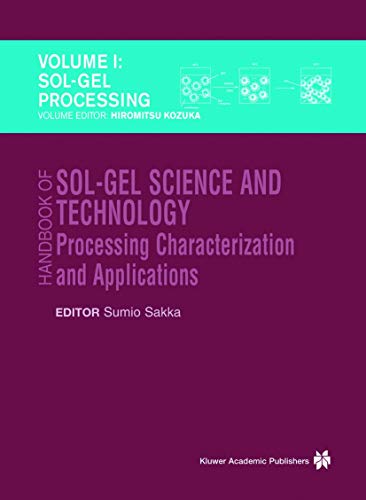Artículos relacionados a Handbook of Sol-Gel Science and Technology: Processing,...
Handbook of Sol-Gel Science and Technology: Processing, Characterization and Applications, V. I - Sol-Gel Processing/Hiromitsu Kozuka, Editor, V. II ... of Sol-Gel Technology/Sumio Sakka, Editor - Tapa dura

From the reviews:
"This three-volume handbook is a compilation of chapters on various topics concerning sol-gels. ... each chapter is self-contained and includes an extensive list of references. The chapters are consistent in style and format ... . This handbook contains a wealth of valuable information ... . Summing Up: Recommended. Graduate students through professionals." (R. Darby, CHOICE, Vol. 42 (10), 2005)
Since Dr. Disiich of Germany prepared a glass lens by the sol-gel method around 1970, sol-gel science and technology has continued to develop. Since then this field has seen remarkable technical developments as well as a broadening of the applications of sol-gel science and technology. There is a growing need for a comprehensive reference that treats both the fundamentals and the applications, and this is the aim of Handbook of Sol-Gel Science and Technology.
The primary purpose of sol-gel science and technology is to produce materials, active and non-active including optical, electronic, chemical, sensor, bio- and structural materials. This means that sol-gel science and technology is related to all kinds of manufacturing industries. Thus Volume 1, Sol-Gel Processing, is devoted to general aspects of processing. Newly developed materials such as organic-inorganic hybrids, photonic crystals, ferroelectric coatings, photocatalysts will be covered.
Topics in this volume include: Synthesis and reaction of sol-gel precursors, Preparation of bulk glass and ceramics, Processing of porous materials based on self-organization, Synthesis of organic-inorganic hybrid materials, Coating of plastics, Special processes used in sol-gel formation of materials (1. Non-hydrolytic sol-gel process, 2. Sonogels, and 3. UV irradiation). Volume 2, Characterization of Sol-Gel Materials and Products, highlights the important fact that useful materials are only produced when characterization is tied to processing. Furthermore, characterization is essential to the understanding of nanostructured materials, and sol-gel technology is a most important technology in this new field. Since nanomaterials display their functional property based on their nano- and micro-structure, "characterization" is very important.
Topics found in Volume 2 include: Determination of structure by NMR, In-situ characterization of the sol-gel reaction process, Determination of microstructure of oxide gels, Characterization of porous structure of gels by the surface measurements, Characterization of organic-inorganic hybrid, Measurements of rheological properties, Measurements of functional properties: fluorescence, laser, non-linear optical and other properties. Sol-gel technology is a versatile technology, making it possible to produce a wide variety of materials and to provide existing substances with novel properties. This technology was applied to producing novel materials, for example organic-inorganic hybrids, which are quite difficult to make by other fabricating techniques, and it was also applied to producing materials based on high temperature superconducting oxides.
Volume 3, Applications of Sol-Gel Technology, will cover applications such as: Application of sol-gel method to processing of bulk silica glasses, Bulk porous gels prepared by sol-gel method, Application of sol-gel method to fabrication of glass and ceramic fibers, Reflective and antireflective coating films, Planar waveguides prepared by sol-gel method, Films with micropatterns and two-dimensional photonic crystals, Application of sol-gel method to formation of ferroelectric films, Application of sol-gel method to formation of photocatalytic coating films, Application of sol-gel method to bioactive coating films.
"Sobre este título" puede pertenecer a otra edición de este libro.
- EditorialSpringer
- Año de publicación2001
- ISBN 10 1402079699
- ISBN 13 9781402079696
- EncuadernaciónTapa dura
- Número de páginas520
- EditorSakka Sumio, Sakka S.
(Ningún ejemplar disponible)
Buscar: Crear una peticiónSi conoce el autor y el título del libro pero no lo encuentra en IberLibro, nosotros podemos buscarlo por usted e informarle por e-mail en cuanto el libro esté disponible en nuestras páginas web.
Crear una petición
